The Aldenhaag Golden Fleece of 1509–1559
Stephen Herold, Ph.C., O.B.C.
(With the assistance of Vincent van Vilsteren, Archaeological Curator at the
Drents Museum)
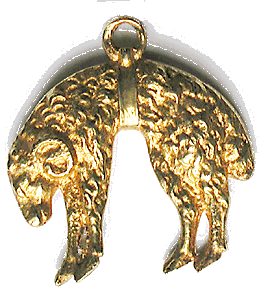
IN our work to discover the history
of the Golden Fleece we have been fortunate to identify some with their original
owners, most noteworthy the Schwarzenbergs and the King of Bavaria. Now we have
another, far older and rarer, fleece whose discovery reads like a treasure hunt
adventure. We will tell the story in five chapters, with appendices and bibliography:
the discovery of the fleece, a brief history of the villages of Thedinghsweert
& Zoelen that are associated with it, the history we have found about this
magnificent fleece of the van Egmond family, a study of Charles V and this form
of fleece and supporting documentation. Note that although in our pages on
the Golden Fleece we generally use the Burgundian French names of knights, here
we use the Dutch version as the Egmonds would have then. Please note some
inconsistency with Dutch names as there appear to be variant spellings used.
The fleece was on display in a show at the
Drents
Museum from March 6 to August 16, 2010 along with a collection of gold from
the ancient Colchis, home of the original Golden Fleece, and is published in
the show catalog that is still available from the museum.
I. Willem’s Picnic Discovery
 In
the late 1960s Willem H. van Duijn (seen at left) enrolled in the Biologisch
Dynamische school, Warmonderhof to study organic and sustainable farming practices.
Such organic techniques that avoid the use of industrial chemicals and pesticides
were taken up years ago in the Netherlands, a rich agricultural country whose
watery land and small area are especially threatened by chemical buildup. Being
at the mouth of the Rhine, one of the most polluted rivers on earth, makes this
concern even more important.
In
the late 1960s Willem H. van Duijn (seen at left) enrolled in the Biologisch
Dynamische school, Warmonderhof to study organic and sustainable farming practices.
Such organic techniques that avoid the use of industrial chemicals and pesticides
were taken up years ago in the Netherlands, a rich agricultural country whose
watery land and small area are especially threatened by chemical buildup. Being
at the mouth of the Rhine, one of the most polluted rivers on earth, makes this
concern even more important.
In 1971 the school moved into the Manor House in the tiny hamlet of Thedinghsweert
in South Gelderland, in the middle of the Netherlands. After settling in, the
students began the walking exploration of the region around Thedinghsweert,
now a suburb of the city of Tiel which is only a kilometer or so away. On one
of these walks around their new home they stopped near some ancient ruins. This
area had been thickly settled since the Middle Ages, and a number of surviving
and ruined buildings are still found across the landscape. While there Willem
noticed a small object sticking from the ground, which he quickly dug out. It
turned out to be a dirty, but somewhat shiny metal ram. We can see in the picture
above where his knife cut into the metal ring at the top (at about 2 o’clock
position).
Finding a keepsake on an walking trip made the day even more special, and Willem
kept the small fleece for the rest of his life. Although its meaning was considered
there was no attempt to do historical sleuthing into its origins or why it was
buried there. Willem died in 1992 and the fleece was inherited by his brother
Dick. Dick thoroughly cleaned the fleece, and reports that it was very dirty
and encrusted so he had to brush it very firmly. Although it was dirty, he also
noted that there was no green corrosion from bronze or copper despite over 400
years in the ground.
Research by the Drents Museum into the finding of this fleece, including talking
to several of van Duijn’s friends who were there, now indicates that although
they lived in Thedinghsweert they more often had their walks near another nearby
castle at Zoelen, only some 2.5 km away from Thedinghsweert. The Zoelen “castle”
is now actually a Renaissance-Reformation estate house built in front of the ruins
of a much older motte and bailey castle that is called Aldenhaag, which likely
dates from the 1263 first mention of the castle. Although this region has many
old castles, Zoelen-Aldenhaag was owned by a member of the Golden Fleece in the
late 16th century named Claes Vijgh who was supposedly appointed in 1559 for his
strong support of the policies of Philip II. This makes him a likely owner of
the fleece.
Dick van Duijn contacted the Confrerie for help in identification, and we determined
by examination:
• This was a genuine and very old style
fleece peculiar to the Low Countries, and later taken to Spain and Portugal,
in the time of Charles V. An early version of the style is seen in a painting
of Charles the Rash where the fleece is fairly solid bodied and upright (seen
just below, left). It is seen fully developed in a Flemish sculpture of
the young Charles V in 1522 (seen just below, center and right), and
by mid century was obsolete. Unlike the later fleeces, whose pinched middle
shows that they are a mere skin of gold, these early ones are almost a standing
live animal held by a hoisting belt (seen just below, right). Their feet
extend straight down, ready to stand when they touch ground.
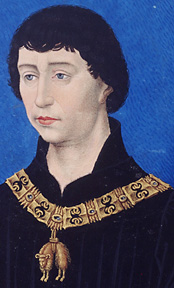
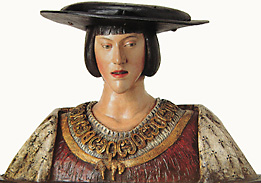
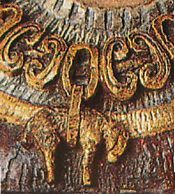
• That it was of a massive form typically
worn both with armor or in daily use from a red ribbon, and the cast ring at
the top shows a groove from exactly such a ribbon ring. The usage of the fleece
determines the design of the top attachment; for collars and bijous the top
ring opens fore and aft to permit attachment, from a ribbon it is a closed loop
and usually inline. Of note is that the front of the fleece has a decorative
dome at the base of the ring that is lacking in the back, despite the full three-dimensionality
of the fleece. The fleece weighs 50 grams and is 5 cm across, making it middle
sized of the five known examples. With only five copies now known it is a very
rare version of the fleece. Known examples are discussed below.
• This front side is very fully sculptured,
and is one of the highest quality ancient fleeces I have seen; the back is much
worn smooth from use and a bit flatter in profile. Certainly proof the fleece
was worn a great deal. But to whom did it belong? and why was it there, intact
in tiny Thedinghsweert or Aldenhaag?
The Standing Ram Form of Golden Fleece
In the early days of the Golden Fleece there
was much local variation since there were no absolute design standards, and
this was especially so in personal wearing copies as here. Since sheep were
much better known than their hanging skins the Low Countries created a version
of the fleece that resembled a solid, living ram rather than his empty skin.
This is referred to here as the “standing ram” form of the fleece.
It was taken to Spain by the entourage of Charles V, but was obsolete everywhere
by the early 17th century, and the fleece then lost weight until it became an
empty skin again. A more thorough examination of the history of the standing
ram fleece and its use in art can be seen on the Standing
Ram Fleece & Charles V page.
The oldest known one is in Munich at the Bayarische
National Museum (No. 338), likely late 15th or beginning of 16th century, bronze
gilt and very worn and battered from use. It is 9 cm wide and seems not well
carved even when new. This fleece looks like it is still grazing grass. Below
left.
Another magnificent 16th century 7.2 cm example
in gold was in the Spada collection (Volume III, p. 242-245) and is likely lost
forever with its theft and probable melting down. Some of the missing Spada
items may have been seen since and so this fine fleece may yet turn up again.
Below second from left.
The third is a 4.3 cm 17th century Hispanic bronze-gilt
example discussed on the Confrérie Amicale Symbols
page. Below third from left.
The fourth was a late, mid-18th century gold
Austrian example, perhaps 3.5 to 4 cm, found in a 1990s catalog. Note that although
the ram is “standing” and solid it is pinched in the middle.
Below far right.
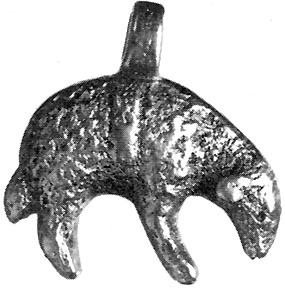
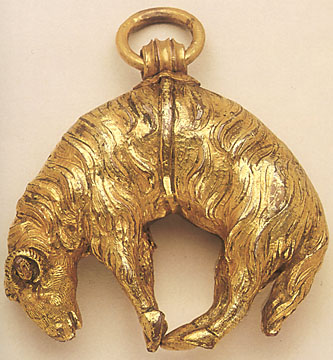
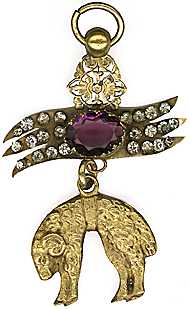
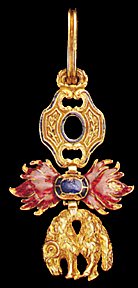
The fifth is the van Egmond or Claes Vijgh fleece
from Aldenhaag: Below, from left to right: Front of the fleece, back of the
fleece, close up of the head of the ram – you can see the wear and polishing
of highlight areas from use. Note also the different designs to the base of
the ring.
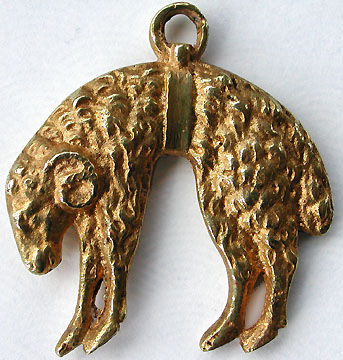
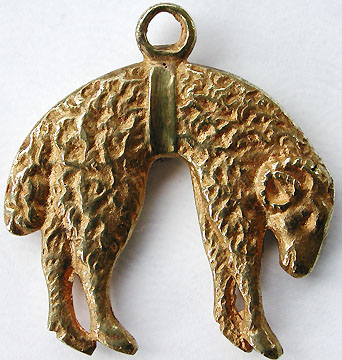
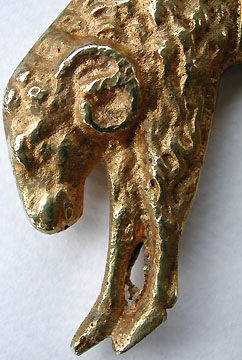
Of five examples known 20 years ago one is already
lost.
II. The Hamlets of Thedinghsweert & Zoelen-Aldedhaag
III. The van Egmonds, Claes Vijgh & The Golden
Fleece
IV. The Standing Ram Fleece & Charles V
V. Documentation & Photos
VB. Documentation & Photos II
Appendix 1. The Standing Ram Fleece As Seen in
the Insignie Orden Book & Other Catalogs
Appendix 2. Other Scholars Look At the Aldenhaag
Fleece
Appendix 3. Greek & Roman Mythology of the Golden
Fleece
3B. Classical Texts
That Mention the Golden Fleece
May 2010 Meeting on the Aldenhaag Fleece — 1. The
Places
May 2010 Meeting on the Aldenhaag Fleece — 2.
The Fleece
Bibliography
Return to Society of the Golden Fleece
Return to the Golden Fleece Insignia Page
Antiques AtoZ Home Page
Medals, Orders
& Decorations



